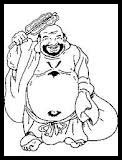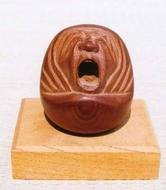[ . BACK to Daruma Museum TOP . ]
:::::::::::::::::::::::::::::::::::::::::::::::::::::::::::::::::::::::::::::::::::::::::::::::::::::
Hotei 布袋 Pu-Tai
one of the
Seven Gods of Good Luck 七福神 Shichifukujin
 Yamashina-E Picture
Daruma and YAMASHINA Paintings - Yamashina-E
Yamashina-E Picture
Daruma and YAMASHINA Paintings - Yamashina-E
Benten 弁天
Bishamonten 毘沙門天
Daikoku 大黒
Ebisu 恵比寿
Fukurokujuu 福禄寿
Hotei 布袋
Juroojin 寿老人
. Seven Gods of Good Luck 七福神 Shichifukujin .
.................................................................................
 Hotei Kokeshi Wooden Doll
- source : ebay 2016 -
Quote from Mark Schumacher:
Hotei Kokeshi Wooden Doll
- source : ebay 2016 -
Quote from Mark Schumacher:
The Shichifukujin are an eclectic group of deities from Japan, India, and China. Only one is native to Japan (Ebisu). Three are from India (Daikokuten, Bishamonten, and Benzaiten) and three from China (Hotei, Jurojin, and Fukurokuju).
The mystery of number seven has enraptured the Japanese as well. Ancient Japan was founded around seven districts. In Japanese folklore, there are seven treasures and seven deities of good luck (the topic of this story). Japanese Buddhists believe people are reincarnated only seven times, and seven weeks of mourning are prescribed following death.
The list goes on and on -- the seven ups and eight downs of life
(Daruma san, you remember), the seven autumn flowers, the seven spring herbs, the seven types of red pepper, the seven transformations, and the popular 7-5-3 festival held each November for children, in which special Shinto rites are performed to formally welcome girls (age 3) and boys (age 5) into the community. Girls (age 7) are welcomed into womanhood and allowed to wear the obi (decorative sash worn with kimono).
Mark Schumacher has many more details and pictures
. . . Mark Schumacher
Link about these seven deities.
http://www.bookmice.net/darkchilde/japan/jgods.html
:::::::::::::::::::::::::::::::::::::::::::::::::::::::::::::::::::::::::::::::::::::::::::::::::::::
The belief in the seven gods of good luck may have started in the Kamakura period as the belief in Ebisu, who had been introduced from India together with Daikoku and Benten. In the Muromachi period, these three were revered together.
Next from India came Bishamonten and then from China
Hotei, Fukurooju and Juroojin.
These seven gods are gathered in one common pilgrimmage for the New Year.
At the beginning of the Edo period Tokugawa Ieyasu started the first set of seven temples from Temple Kanei-Ji in the Ueno area. During the more peaceful time of the seventh Shogun Yoshimune it turned into more of a festivity and tourism and spread over all of Japan.
Nowadays, people visit these temples often as a kind of hiking entertainment or stamp ralley, but it never lost in its popularity.
visiting the temples of the seven gods of good luck
shichifukujin mairi 七福神参り
kigo for the New Year
Saijiki of Ceremonies in Japan
 From the Daruma Museum
Seven Gods of Good Luck as Daruma Dolls 七福神だるま
From the Daruma Museum
Seven Gods of Good Luck as Daruma Dolls 七福神だるま
:::::::::::::::::::::::::::::::::::::::::::::::::::::::::::::::::::::::::::::::::::::::::::::::::::::
 source : jugem.jp
source : jugem.jp
Hotei sama 布袋さま
Hotei 布袋 Pu-tai, Bu-Tai, Bu-Dai 布袋
Quoting from my book about Buddha Statues
- Buddhastatuen ... Who is Who
He is the god of contentment and happiness. He is the only one of the seven deities who is modelled after a real person, the Chinese Zen Priest Kaishi (Ki-hi) , who lived around 900 in T'ang China in the Mountain Temple Shimeizan. He wandered around in the country, carrying his few belongings in a big sack. He freely shared his things with people in need and the local children all loved to be around him.
In his free way of life he teaches us to cultivate a mind free of worry and a heart free of wishes, since these are greater treasures than anything else you can carry around in this world.
He is known to be an incarnation of the Bodhisattva Maitreya (Miroku Bosatsu) the Future Buddha.
His iconography is simple:
An old, bold man who carries a huge bag. His robe is open and shows his huge belly. Sometimes he holds a Chinese fan (uchiwa) in his hand. Many illustrations show him resting on his huge bag. He is very often represented in Bizen Pottery.

Here you can see him carrying the wishfulfilling jewel and with a child at his side, as quoted by Darkchilde.
. takarabukuro 宝袋 the Treasure Bag of Hotei .
:::::::::::::::::::::::::::::::::::::::::::::::::::::::::::::::::::::::::::::::::::::::::::::::::::::
At the Temple 万福寺 Manpuku-Ji in Kyoto, there is this statue

Hotei is thought to be based on a Chinese monk named
Bu-dai, who became identified as an incarnation of Miroku, the Bodhisattva of the future. The statue is kept in the Tenno-den (Heavenly Kings Hall) of the temple.
http://www.art-and-archaeology.com/japan/mampukuji8.html
:::::::::::::::::::::::::::::::::::::::::::::::::::::::::::::::::::::::::::::::::::::::::::::::::::::
Hotei Daruma on a Stone
石ころに彩色した布袋達磨。 群馬県みなかみ町の“たくみの里”産

© Hisamaro, Seven Goods of Good Luck
七福神グッズいろいろ
::::::::::::::::::::::::::::::::::::::::::::::::::::::::::::::::::::::::::::::::::::::::::::
Here is another version of his legend.

He is the god of happiness, laughter and the wisdom of contentment, and is the patron of the weak and children, fortunetellers and bartenders. Hotei is distinguished by his body of generous proportions and round stomach exposed beneath loose robes. His big belly is a symbol of happiness, luck and generosity. On his back he carrys a huge linen bag containing precious things and gifts of good fortune, including children. He also holds an uchiwa, a flat fan of Chinese orgin used by ancient chieftains as an emblem of authority and wish granting. He may sit in an old cart drawn by boys, as the Wagon Priest, and can be compared with the Buddhistic Mi-lo-Fo.
In Chinese Buddhism he is known as
Budai, the Loving or Friendly One. He was a wandering Chan Buddhist monk who lived in the ninth century. At his death between 901 and 903, he recited a poem that revealed to the world that he was in fact the Bodhisattva Maitreya in disguise. Maitreya, Chinese Buddhists believe, is the future buddha, who will return to the world and bring innumerable individuals to salvation. This concept of hope for the suffering, combined with Budai's pleasing, human features, made him a most popular Buddhist deity. It was not until the sixteenth century that he was canonised as the sixteenth and last Chinese bodhisattva.
According to Chinese legend he carried a sack of candy to give to children.
He is sometimes worshipped as a god of good luck and prosperity. He is always represented as very stout, with the breast and upper abdomen exposed to view. His face has a widely grinning or laughing expression, and he is also known as the Laughing Buddha. He stands in the first hall of the Buddhist monastery. Because of his constant good nature, he has become the symbol of philosophical contentment.
http://www.holymtn.com/gods/hotei.htm
:::::::::::::::::::::::::::::::::::::::::::::::::::::::::::::::::::::::::::::::::::::::::::::::::::::
 CLICK for more photos !
「布袋の大仏」-The Great Hotei Statue
CLICK for more photos !
「布袋の大仏」-The Great Hotei Statue
Aichi prefecture, Konan town 愛知県江南市
- - - The Grandfatherly Buddha of Hotei
Visible from the train between Hotei Station and Konan Stations on the Meitetsu Inuyama Line, the 18m high Hotei Buddha was erected in 1954 by successful local Moxibustion practitioner, Maeda Hidenobu. The Hotei Buddha is popular with travelers on the train line, and with photographers, particularly in spring, when the Buddha is surrounded by clouds of pink cherry blossom.
- source : aichi-now.jp/en/features-
.......................................................................
兵庫県姫路市夢前町寺 Himeji, Sumesakichotera
:::::::::::::::::::::::::::::::::::::::::::::::::::::::::::::::::::::::::::::::::::::::::::::::::::::
Hotei painted by Miyamoto Musashi

Fukuoka Art Museum
布袋見闘鶏図
宮本武蔵は江戸時代前期の剣豪で、二天一流剣法の始祖です。書画にもすぐれた武蔵は、南宋の梁楷の減筆体や海北友松の画風を学び、気迫のこもった水墨画を残しました。この布袋見闘鶏図には、伝・梁楷、海北友松の作品にも同じ図様のものが見られますが、全体的には友松の作品に近いといえます。まさに飛びかからんとしてにらみ合う二羽の鶏を、布袋は悠然と眺めおろしています。この作品の旧蔵者である茶人・松永耳庵は「布袋という絶対者が、争いの絶えない世間を見つめている」と喝破しました。終生戦いの場に身を置いた宮本武蔵が辿りついた境地として見れば、興味は尽きません。
http://www.fukuoka-art-museum.jp/jc/html/jc05/01/hotei.html
More famous paintings of Hotei
By Doi San 土井利位 筆
http://www.city.koga.ibaraki.jp/rekihaku/sekka/1-4.htm
By 黙庵霊淵(?~1345?)
http://www.sumitomo.gr.jp/related/senoku02/ipix/exhibit01.html
:::::::::::::::::::::::::::::::::::::::::::::::::::::::::::::::::::::::::::::::::::::::::::::::::::::
Hotei, being a cheerful, contented Buddhist monk, is a wonderful little icon; where just the appearance can have the ability to cheer anyone up from a bad day. His largely exposed, pot-belly stomach protrudes in front of him as he continues to laugh through never ending time. This familiar looking statue can be found just about anywhere in the world, and maybe better known as
the Laughing Buddha.
The name Hotei actually means "cloth bag" or "glutton."
A legend has it that if a person is to rub his belly, it brings forth wealth, good luck, and prosperity.
from albrecht
:::::::::::::::::::::::::::::::::::::::::::::::::::::::::::::::::::::::::::::::::::::::::::::::::::::
Hotei carrying a lady across the stream

Nishimura Shigenaga 1697-1756
Read more about this deity.
http://www.bookmice.net/darkchilde/japan/jgods.html
:::::::::::::::::::::::::::::::::::::::::::::::::::::::::::::::::::::::::::::::::::::::::::::::::::::
 Courtesan and Hotei Smoking on a Veranda in Moonlight
Courtesan and Hotei Smoking on a Veranda in Moonlight
Suzuki Harunobu (1725 – 1770)
:::::::::::::::::::::::::::::::::::::::::::::::::::::::::::::::::::::::::::::::::::::::::::::::::::::
 Hotei on a plate made by Kakiemon, Arita.
Hotei on a plate made by Kakiemon, Arita.
柿右衛門 色絵布袋図皿
http://www.umakato.jp/tanakamaru/sk_006.html
Another Kutani plate with Hotei
 .. //shofu.pref.ishikawa.jp/shofu/intro/
.. //shofu.pref.ishikawa.jp/shofu/intro/
::::::::::::::::::::::::::::::::::::::::::::::::::::::::::::::::::::::::::::::::::::::::::::
. Seven Fushimi dolls of Hotei 布袋
. . . . .
Read a lot more here in an essay by Jennifer Polden.
... onmarkproductions.com/html- hotei_by_jennifer_polden.htm
::::::::::::::::::::::::::::::::::::::::::::::::::::::::::::::::::::::::::::::::::::::::::::
You can buy a lot of lucky charms with Hotei here:
 http://www.luckfactory.com/chinahoteibuddha1.html
http://www.luckfactory.com/chinahoteibuddha1.html
 source : popeye.sakura.ne.jp...
source : popeye.sakura.ne.jp...
 布袋 土鈴 dorei
Clay bell with Hotei
布袋 土鈴 dorei
Clay bell with Hotei, click for more !

布袋 絵馬 ema
votive tablet with Hotei, click for more !
:::::::::::::::::::::::::::::::::::::::::::::::::::::::::::::::::::::::::::::::::::::::::::::::::::::
 . WKD : Hotei aoi ほていあおい Common Water Hyacinth .
:::::::::::::::::::::::::::::::::::::::::::::::::::::::::::::::::::::::::::::::::::::::::::::::::::::
. WKD : Hotei aoi ほていあおい Common Water Hyacinth .
:::::::::::::::::::::::::::::::::::::::::::::::::::::::::::::::::::::::::::::::::::::::::::::::::::::
:::::::::::::::::::::::::::::::::::::::::::::::::::::::::::::::::::::::::::::::::::::::::::::::::::::
Die sieben Glücksgötter (Shichi Fukushin)
Besondere Gruppierung "ausländischer" Gottheiten.
Daikokuten, Bishamonten und Benten sind indische Gottheiten, Ebisu ist eine rein japanische Gottheit. Hotei und Fukurokujuu sind chinesischen Ursprungs.
Seit der Muromachi-Zeit besonders von Geschäftsleuten verehrt. Sechs männliche und eine weibliche (Benten) Gottheit. Entweder alle in einem Tempel aufgestellt oder für jede Gottheit ein eigener Tempel, die in den Neujahrstagen alle abgepilgert werden müssen. In einigen Tempeln befinden sich sieben besonders große, auffallend geformte Natursteine, welche die Gottheiten darstel~len.
Oft zusammen auf einem Glücksschiff (takarabune) dargestellt, auf dessen Segel das Schriftzeichen für "Schätze" (takara) steht. Dieses Bild ist besonders am Neujahrsfest glückbringend.
Eventuell aus dem alten Brauch des "Siebenmal Anbeten" (nanado mairi) entstanden, bei dem zum Gionfest in Kyooto an einem Tempel sieben Mal hintereinander ein Gebet gesprochen werden mußte, damit es wirksam wurde. Die Zahl "SIEBEN" ist seit alter Zeit mit Glück verbunden. Es gab auch den Brauch, sieben Statuen des Hotei nebeneinander aufzustellen.
In der Edo-Zeit am 2. Januar legte man sich ein Bild der Glücksgötter unter das Kopfkissen, um einen guten ersten Traum im neuen Jahr zu haben.
Die meisten Gottheiten wurden bei den
Ten bereits besprochen, siehe dort.
 Hotei
Hotei
Chinesischer Zenpriester Kaishi (Kihi) des Tempels Shimeizan; lebte in der T'ang-Zeit. Wanderte bettelnd durchs Land, spielte mit den Kindern, trug seine Habe in einem großen Sack mit sich herum. Inkarnation des Miroku Bosatsu. Er lehrte, daß ein Geist frei von Sorgen und ein Herz frei von Wünschen wertvoller sei als alle weltlichen Schätze dieser Erde.
Ikonografie:
Alter, lachender, kahlköpfiger Priester-Schelm. Offene Kleidung, mit herausragendem dickem Bauch. Mit großem Sack, auf dem er oft ausruht; in der Hand einen chinesischen Fächer.
.Buddhastatuen ... Who is Who
Ein Wegweiser zur Ikonografie
von japanischen Buddhastatuen
Gabi Greve, 1994
:::::::::::::::::::::::::::::::::::::::::::::::::::::::::::::::::::::::::::::::::::::::::::::::::::::
. Matsuo Basho 松尾芭蕉! .
(when Basho was about 45 years old)
On a portrait of Hotei, Basho wrote:
物ほしや袋のうちの月と花
monohoshi ya fukuro no uchi no tsuki to hana
How much I desire !
Inside my little satchel
the moon and flowers
Tr. David Landis Barnhill in
Narrow Road to the Interior
- source : Shambhala Publications, Nov 14, 2006-
Another version by Barnhill
so desirable —
inside his satchel
moon and blossoms
source : basho | Haiku | Poetry - Scribd
Basho is pondering about the large sack of Hotei:
I want to have it !
inside his bag there are
the moon and the blossoms
- the autumn moon and the cherry blossoms . . .
symbols for all the good things of the four seasons.
Basho's poem probably refers to this one by
烏丸光弘
Karasuma Mitsuhiro (1579 - 1638)
大空をさしたる指の先にこそ月雪花も秋の紅葉も
.......................................................................

Tsukioka Yoshitoshi (1839-1892)
:::::::::::::::::::::::::::::::::::::::::::::::::::::::::::::::::::::::::::::::::::::::::::::::::::::
. Folk Toys and the Seven Gods of Good Luck
. Seven Gods of Good Luck 七福神 Shichifukujin .
[ . BACK to WORLDKIGO . TOP . ]
[ . BACK to DARUMA MUSEUM TOP . ]
- #hotei -
:::::::::::::::::::::::::::::::::::::::::::::::::::::::::::::::::::::::::::::::::::::::::::::::::::::












































